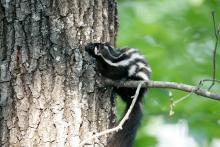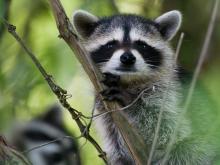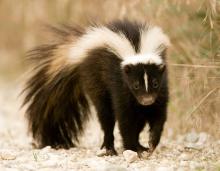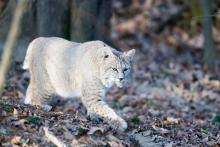Mammals
Media

Species Types
Scientific Name
Spilogale interrupta (formerly Spilogale putorius interrupta)
Description
Of the two species of skunks in Missouri, the spotted skunk is smaller, less common, and lesser known. It has been declining drastically in recent years because of habitat loss.
Media

Species Types
Scientific Name
Procyon lotor
Description
When you see the black mask and striped tail of this medium-sized mammal, you know you’ve spotted a raccoon. These nocturnal omnivores are clever and adaptive.
Media

Species Types
Scientific Name
Mephitis mephitis
Description
Skunks are omnivorous mammals notorious for their ability to discharge an obnoxious scent when provoked. The striped skunk is the most commonly encountered skunk in our state.
Media

Species Types
Scientific Name
Ursus americanus
Description
One of the largest wild mammals in Missouri, the American black bear is unmistakable with its black fur and powerful bearing.
Media

Species Types
Scientific Name
Canis lupus
Description
The gray wolf originally ranged throughout Missouri, but with settlement the species was gradually exterminated. While there is no evidence of a breeding population in the state, wolves are listed as a protected species in Missouri, and they occasionally wander into Missouri from northern states.
Media

Species Types
Scientific Name
Lynx rufus
Description
The bobcat is a short-tailed wild cat with a distinctive streaked and spotted pattern, a wide face, and pointy ears often with black tufts.
Media

Species Types
Scientific Name
Sus scrofa
Description
Feral hogs cause millions of dollars in agricultural, environmental, and property damage. As they root and wallow, they plow the soil to depths of 2–8 inches — sometimes for many acres! And this is just the beginning of the trouble they can cause to humans, livestock, and the environment.
Media

Species Types
Scientific Name
Perimyotis subflavus (formerly Pipistrellus subflavus)
Description
Tri-colored bats, formerly called eastern pipistrelles, are relatively small and look pale yellowish or pale reddish brown. The main hairs are dark gray at the base, broadly banded with yellowish brown, and tipped with dark brown.
Media

Species Types
Scientific Name
Myotis sodalis
Description
The Indiana myotis, or Indiana bat, summers along streams and rivers in north Missouri, raising its young under the bark of certain trees. It is an endangered species.
Media

Species Types
Scientific Name
Myotis lucifugus
Description
The little brown myotis (little brown bat) is one of our most common bats, but populations are declining. White-nose syndrome has taken a heavy toll in northeastern states. This species is now listed as vulnerable across its range.
See Also
About Mammals in Missouri
More than 70 species of wild mammals live in Missouri: opossums; shrews and moles; bats; rabbits; woodchuck, squirrels, beaver, mice, voles, and other rodents; coyote, foxes, bear, raccoon, weasels, otter, mink, skunks, bobcat, and other carnivores; deer and elk; and more. Most of us recognize mammals easily — they have fur, are warm-blooded, nurse their young, and breathe air.





















